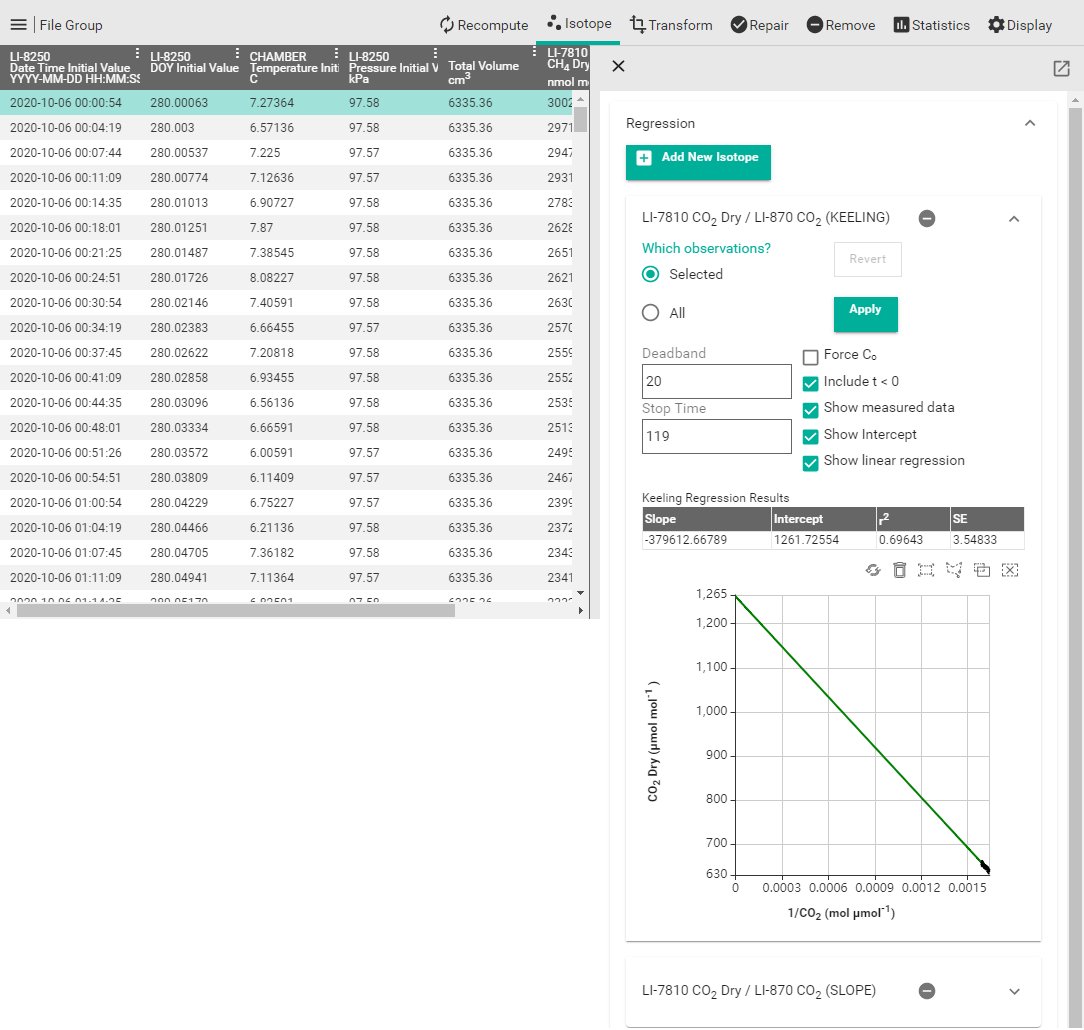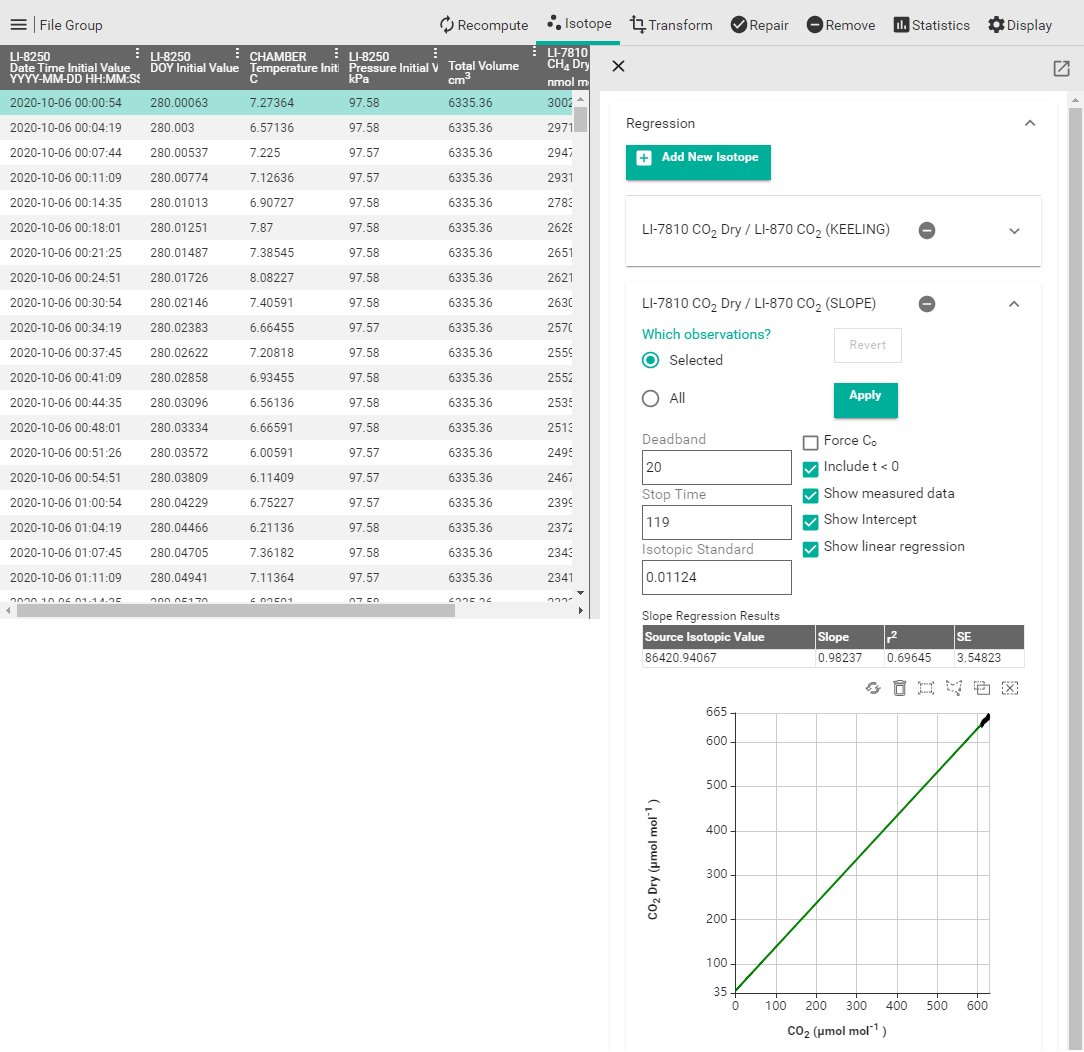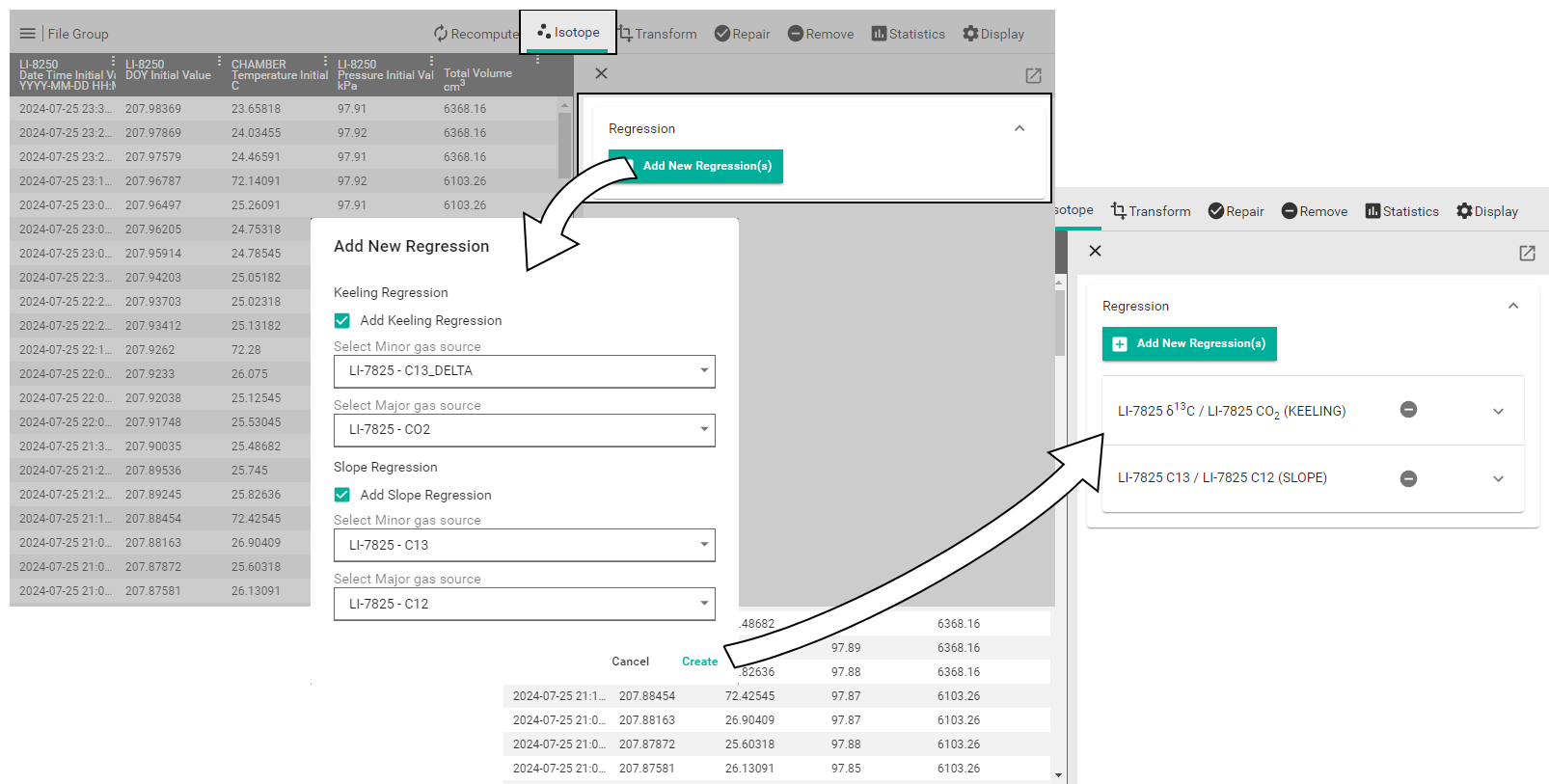Working with isotope measurements
Data from the LI-7825 CO2 Isotope/NH3 Trace Gas Analyzer include measurements of CO2 isotopologues. SoilFluxPro Software can evaluate these data using the Slope and Keeling Regression methods. The Isotope tab allows the assignment of a Major Gas and Minor Gas for the regression.
To add a new regression:
-
Open the Isotope tab and click Create New Regression.
-
Use the default settings or select a Major Gas and Minor Gas from the available variables, then click Create.
-
Two new regressions are created - Keeling and Slope.
Each regression object presents options. Expand the object to view them.
-
Which observations?
-
Selected will display a plot and table of data, along with options to adjust the parameters for the measurement selected in the data display.
-
All will show options that can be adjusted for all measurements.
-
-
Apply: Click to apply changes.
-
Revert: Click to discard and revert to the prior state.
You can view a plot and table of the Major Gas/Minor Gas or the Keeling plot when a single observation is selected.
-
Keeling regression
The Keeling regression method uses C13_DELTA and CO2 as minor and major gases by default. These gases are used to name variables in the data file. If you select different gases when creating the regression, the variable name in the data file indicates the gases. The x-axis of the Keeling plot shows 1/major gas. The source estimate comes from the y-intercept of linear regression of the minor gas over 1/major gas.
| Interface variable |
Units | Data file variable | Description |
|---|---|---|---|
| Major Gas | µmol mol-1 | MAJOR_GAS | Major gas species used to compute the regression (default is CO2). |
| Major Gas Source | - | MAJOR_GAS_SOURCE | Instrument that measured the major gas; e.g., LI-7825 |
| Minor Gas | µmol mol-1 | MINOR_GAS | Minor gas species used to compute the regression (default is C13_DELTA). |
| Minor Gas Source | - | MINOR_GAS_SOURCE | Instrument that measured the minor gas; e.g., LI-7825 |
| Deadband | s | MAJOR/MINOR (KEELING) DEADBAND | Deadband length; e.g., C13_DELTA/CO2 (KEELING) DEADBAND. |
| Stop Time | s | STOP_TIME | Final data point used for the regression. |
| Slope | ‰ per (µmol mol-1) | MAJOR/MINOR (KEELING) SLOPE | Slope of linear fit; e.g., C13_DELTA/CO2 (KEELING) Slope |
| Intercept | ‰ | MAJOR/MINOR (KEELING) INTERCEPT | Y intercept of linear regression; e.g., C13_DELTA/CO2 (KEELING) INTERCEPT |
| R2 | - | MAJOR/MINOR (KEELING) r2 | Coefficient of determination; e.g., C13_DELTA/CO2 (KEELING) r2 |
| Intercept SE | ‰ | MAJOR/MINOR (KEELING) int_se | Standard error of regression intercept term; e.g., C13_DELTA/CO2 (KEELING) int_se |
| Slope SE | ‰ | MAJOR/MINOR (KEELING) slope_se | Standard error of regression slope term; e.g., C13_DELTA/CO2 (KEELING) slope_se |

Slope regression
The Slope regression method uses C13 and C12 as minor and major gases by default. These gases are used to name variables in the data file. If you select different gases when creating the regression, the variable name in the data file indicates the gases. A new slope regression is automatically set to 0.0112372 (the interface displays 0.01124). The source isotopic value is calculated from the slope of a linear fit of the major gas over minor gas standardized to the isotopic standard value:
4‑1source isotopic value = (slope/standard − 1) × 1000
| Interface variable |
Units | Data file variable | Description |
|---|---|---|---|
| Major Gas | ‰ | MAJOR_GAS | Major gas species used to compute the regression; e.g., C12 |
| Major Gas Source | - | MAJOR_GAS_SOURCE | Instrument that measured the major gas; e.g., LI-7825 |
| Minor Gas | ‰ | MINOR_GAS | Minor gas species used to compute the regression; e.g., C13 |
| Minor Gas Source | - | MINOR_GAS_SOURCE | Instrument that measured the minor gas; e.g., LI-7825 |
| Deadband | s | MAJOR/MINOR (SLOPE) DEADBAND | Deadband length; e.g., C12/C13 (SLOPE) DEADBAND |
| Stop Time | s | MAJOR/MINOR (SLOPE) STOP_TIME | Final data point used for the regression. |
| Isotopic Standard | - | MAJOR/MINOR (SLOPE) STANDARD | Isotopic standard value = 0.0.0112372; e.g., C12/C13 (SLOPE) STANDARD |
| Slope | Dimensionless | MINOR/MAJOR (SLOPE) SLOPE | Slope of linear fit; e.g., C13/C12 (SLOPE) SLOPE |
| Intercept | Same as minor gas | MINOR/MAJOR (SLOPE) INTERCEPT | Y intercept of linear regression; e.g., C13/C12 (SLOPE) INTERCEPT |
| Source Isotopic Value | ‰ | MINOR/MAJOR (SLOPE) ISOTOPIC_VALUE | Isotopic standard value; e.g., C13/C12 (SLOPE) ISOTOPIC_VALUE |
| R2 | - | MINOR/MAJOR (SLOPE) r2 | Coefficient of determination; e.g., C13/C12 (SLOPE) r2 |
| Intercept SE | Same as major gas | MINOR/MAJOR (SLOPE) int_se | Standard error of the slope intercept; e.g., C13/C12 (SLOPE) int_se |
| Slope SE | Same as major gas | MINOR/MAJOR (SLOPE) slope_se | Standard error of the regression slope term; e.g., C13/C12 (SLOPE) slope_se |

